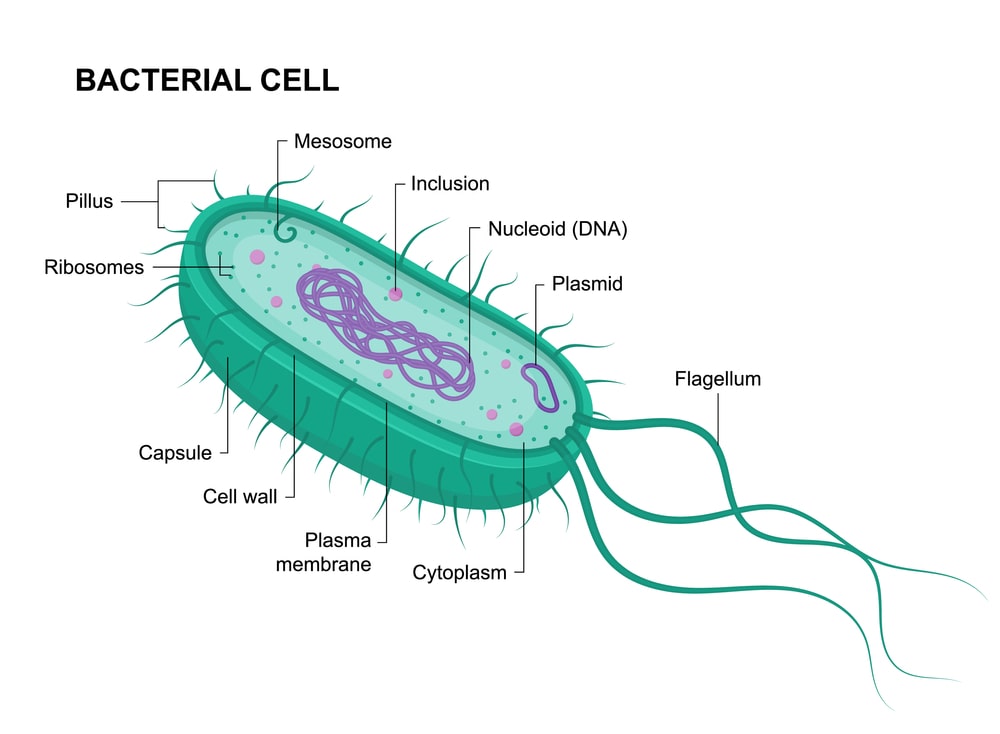Bacterium (pl. bacteria) refers to a single-celled organism without having a true nucleus or functionally specific components of metabolism that belongs to the kingdom Prokaryotae (Monera). The internal cytoplasm is invariably surrounded by a one-or two-layered rigid cell wall composed of phospholipids. Some bacteria also produce a specific mucoid extracellular capsule for additional protection, particularly from phagocytosis by white blood cells (WBCs). Bacteria can synthesize nucleic acids (DNA, RNA), and other important proteins and can reproduce independently, but may essentially need a host to supply food and also a supportive environment. In reality, millions of nonpathogenic bacteria live on the skin and mucous membranes of the human gastrointestinal tract (GIT); these are termed normal flora. Importantly, bacteria that cause disease are usually known as pathogens.
Characteristic Features of Bacteria
A few vital and cardinal characteristic features of ‘bacteria’ are as enumerated under:
1. Shape
There are three principal forms of bacteria, namely:
- Spherical or Ovoid — bacteria occur as single cells (micrococci), or in pairs (diplococci), clusters (staphylococci), chains (streptococci), or cubical groups (sarcinae);
- Rod-shaped — bacteria are termed bacilli, more oval ones are known as coccobacilli, and those forming a chain are called streptobacilli ;
- Spiral — bacteria are rigid (spirilla), flexible (spirochaetes), or curved (vibrios).
2. Size
An average rod-shaped bacterium measures approximately 1 μm in diameter and 4 μm in length. They usually vary in size considerably from < 0.5 to 1.0 μm in diameter to 10–20 μm in length in some of the long spiral forms.
3. Reproduction
It has been observed that simple cell division is the usual method of reproduction, whereas certain bacteria give rise to buds or branches that eventually break off. The growth rate is substantially affected on account of changes in temperature, nutrition, and other factors.
Importantly, bacilli can produce reproductive cells invariably termed spores, whose relatively thick coatings are highly resistant to adverse environmental conditions. In the event of a better congenial environment, the spores commence growing. Besides, spores are difficult to kill as they are highly resistant to heat as well as disinfectant action.
4. Formation of Colony
A group of bacteria growing in one particular place is known as a colony. A colony is invariably comprised of the ‘descendants of a single cell’. It has been found that colonies differ in shape, size, color, texture, type of margin, and several other characteristic features. Interestingly, each species of bacteria has a characteristic type of colony formation.
5. Mutation
A majority of bacteria, like all living organisms, do possess the ability to adapt their shape or functions when encountered with distinct changes in their environment, but there is a certain degree of limits to this ability. However, they may also mutate to adapt to some potentially lethal sub-stances, for instance: antibiotics.
6. Motility
It has been duly observed that none of the ovoid or spherical cocci are capable of moving, but certain bacilli and spiral forms do exhibit absolute independent movement. It is, however, pertinent to mention here that the power of locomotion exclusively depends on the possession of one or more flagella, slender whiplike appendages which more or less work like propellers.
7. Food and Oxygen Requirements
Bacteria are of different types based on their food and oxygen requirements as given below:
- Heterotrophic: requires organic material as food,
- Parasites: feed on living organisms, H
- Saprophytes: feed on non-living organic material,
- Autotrophic: i.e., self-nourishing-obtain their energy from inorganic substances, including most of the soil bacteria,
- Aerobes: essentially require oxygen for their very existence and growth, and
- Anaerobes: do not require oxygen for their existence and growth. e.g., most bacteria found in the GIT.
8. Temperature Requirements
Although some bacteria live at very low temperatures or very high temperatures; however, the optimum temperature for a majority of pathogens is 37 °C (98.6°F).
Make sure you also check our other amazing Article on : Heavy Metal Poisoning
